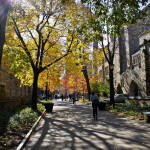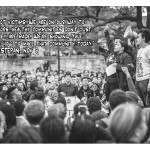by Carlene Ervin
I didn’t know that private schools existed. Within my sphere of knowledge in Oakland, CA of public and charter schools battling for state funding, private schools were a dreamland. For all I knew private schools were Hollywood’s inventions in order to sell the stories of rich kids’ childhood drama. Where I’m from, some schools had trouble providing desks for all the enrolled students. It was unfathomable that in this country there exist high schools that have seminar-style classrooms with only 12 students who sit at circular tables, engaged in “intellectual” conversations.
When I was admitted into Yale, I saw that seminars not only existed but were emphasized in Yale’s learning culture. My first interaction with seminars came before the start of my freshman year. I was invited to participate in the Freshman Scholars at Yale (FSY) program, which offered English 114 as class to help students academically transition to Yale.
When I learned that English 114 was seminar style I almost backed out of participating because I had never been in a situation where students’ voices were so central to the learning environment. Looking back, I now realize that FSY couldn’t paint the full picture of what Yale would be like. Most students in FSY had similar experiences with race, poverty, and attending public schools. We brought those experiences to the classroom and often validated and understood each others’ experience.
I was nervous when a lot of upperclassmen told me that the best classes at Yale were seminars, and even more stressed when I found out that all lectures had discussion sections. Instead of having a professor teach new information, sections are entirely based on peer to peer learning and the entire time is devoted to student discussion. I would walk into a seminar and there would be twelve students sitting around a large oval table. Six students would be white men, two would be Black men, one would be a white woman, one would be an Asian woman, and I would be the lone Black woman. According to a Yale Daily News survey of the Class of 2018, about 50% of students went to private high schools and 3 of 5 students paid over $20,000 a year for their high school education. I soon found that these racial and economic demographics were barriers that prevent me from fully participating in classroom discussions.
In some small classrooms I thrived. In my English 120 (Reading and Writing the Modern Essay) seminar I was the person who expressed the unpopular opinions. I had a relationship with the professor from FSY and felt comfortable being myself because she knew that I was not being malicious and that my feelings were valid. This gave me the courage to express my opinions fully.
In other sections, I was the quiet freshman, intimidated by the upperclassmen who had the confidence to appear much smarter then they were. Sections are also hard when you feel like you connect to text in different ways than most people do. When I would talk in section, I felt like everyone was giving me weird looks because they couldn’t identify with my experience or appreciate its intellectual value. Even when I was in predominately white spaces with one other Black student, there wasn’t often the opportunity to connect because the whiteness of the room and the topic of discussion was stifling. These moments were often the times that I felt the most alienated at Yale.
The first semester of my sophomore year, I took an African American Studies course that met at the Af Am House. For the first time I felt connected to the House as I saw so many beautiful Black faces smiling back at me, ready to learn about our collective and separate identities in a social and academic space. This class was one of the most beautiful experiences that I had at Yale. The beauty in the class was that there wasn’t a monolithic experience of Blackness. We had first generation Americans, students from the Continent, descendants of slaves, people from the islands and so much more.
The class was also challenging in some aspects, because it highlighted the economic differences between me and some of my Black peers who had gone to private school. There were sometimes classist undertones in the ways that they interpreted Black text that was hard to reconcile with my experience of growing up in a low income urban environment. Despite this, we were still in a predominately Black space where it felt safe to explore our differences. We weren’t fighting against the oppressive white male presence that I experienced in some of my other seminars.
Being in an academic setting with people who looked like me was an addicting classroom experience, and I crave to go back to last semester just to be in that space. A mostly Black academic environment is a rare occurrence because Yale’s academic system has historically put more value on white male voices, both in the learning environment and in the texts we engage with. Low income, first generation, students of color will continue to feel silenced. Programs like FSY are helpful for community building, but nothing will change the fact that the “traditional” Yale student will have the upper hand in a small classroom environment. In order to push back against 315 years of the traditional Yale classroom discussion, we need to restructure the conversation to value all of the voices present.



